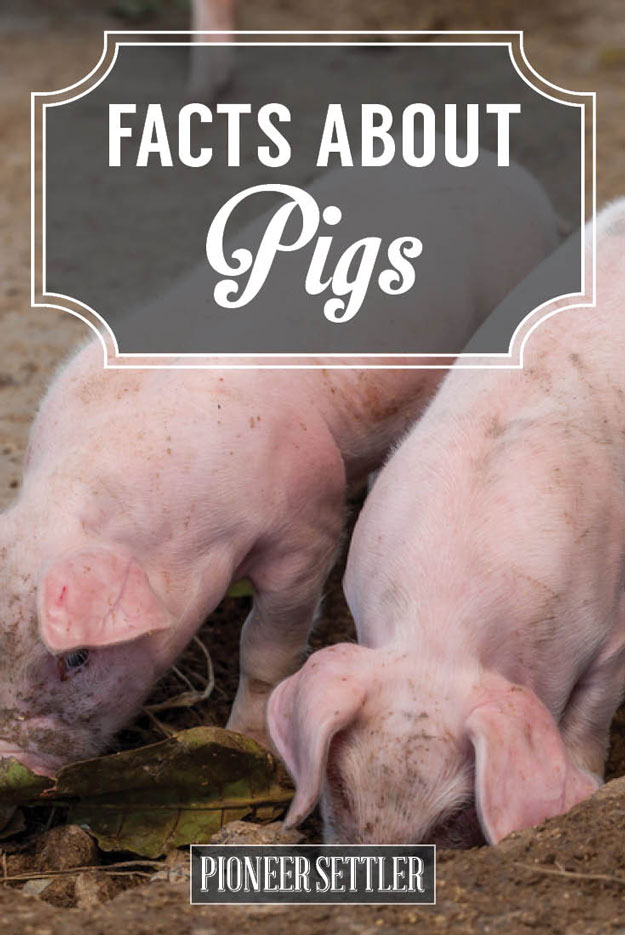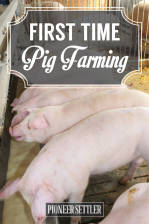Ready to learn some interesting pig facts? Having your very own fresh roasts, sausage, chops, savory ham and dense slices of bacon are just a few reasons why there are people who prefer to raise pigs on their homestead.
So whether you're a seasoned pig expert or simply curious about these animals, we can all agree that there is more to them than just rolling around in the mud. Read on to learn important pig facts!

What Does an Ideal Pig Look Like?
On average, a pig is around 200-280 pounds. Pigs swiftly attain this weight once they are about six months in age. Since time and resources are a must when raising them, it is necessary to start with high quality, quick growing pigs. The best pigs characteristically have long torsos and deep sides. Their sides should also be lengthy as well as their overall appearance from head to tail. Good pigs are visibly meaty and have large shoulder and rear muscles.
Basic Pig Facts: What To Look For
You do not want to choose pigs that have large shoulder muscles and have light muscling at their rear that is the most valuable part of the pig. When you are looking at a pig from the rear, the widest area of the ham must be two-thirds the distance from their surface. A pig's loin should be thick and wide. Try and keep away from those that have wide at the top, but narrow at the bottom.
Other methods of muscling are viewing the length of their chest. Seeing it at a frontal point of view will show the length of their chest. Viewing a pig from the back will show you the width between their hind legs. Pigs that possess dense muscles stand wide at the rear and frontally. The best kind of pig is physically lean. Make sure to look at their belly and beneath their chin. Nothing should appear flabby, it should be trim. You also want a pig to be structurally sound. You want pigs that can easily saunter around their surrounding and show no indication of stiffness or lameness.
Pig Facts From The Beginning
While pigs are young, they are often weaned from sows by the time they reach six to eight weeks. This age is also the perfect time for them to be bought as meat, but ensure you get a weaner pig that is thick and long. If you happen to buy a weaner pig around forty pounds, it will need to gain about two pounds daily for pigs to meet market weight when they are about six months of age.
Know Their Roots
When you can, monitor the sow and boar that make the litter. You will want to know whether or not the previous litters met desirable market rate in six months. See if you can learn if the pigs put on one to two pounds daily when they are being fed. You might additionally want to know if the pig’s parents have desirable conformations. Remember to chat with a breeder about their potential growth rate; there are various popular pig breeds you could choose from if you want to have the best and quickest quality of meat.
???? Tales from a first-time pig farmer… https://t.co/i62gP5gvBZ pic.twitter.com/iAlwUl9Ve6
— Homesteading (@HomesteadingUSA) May 2, 2016
Pig Types
The white, erect eared Yorkshire, the white, big-eared Landrace, the white-striped, black Hampshire, and the red Duroc are a few good breeds. Often, other pig breeds that are used end up being a cross of one of these breeds. If there is a financial complication when you are buying pigs, it is best to speak with a breeder if they have any “runts” available. More often than not, there will be one or a couple of them within the litter.
If you do get the babies, they are required to have around the clock feeding times until they are ready to consume solid foods. Young pigs reach that stage when they are about a month of age. Some breeders may give small pigs to buyers who can properly take care of them. Pigs that have excellent genetics will typically catch up in size along with their other, larger sized litter mates.
Selecting the Perfect Pig
Having clean and healthy pigs are an absolute must for anyone looking to have a successful meat raising business of their own. Try consulting with the local veterinarian or county extension agent about common diseases that pigs could contract where you live. Choose your pigs wisely from breeders that have a sound healthcare program.
It is best not to give even a second look at pigs with runny noses, respiratory complications, diarrhea, or one that simply does not look lively. If there is a pig, that should be a breeding sow or boar, make sure you consider additional characteristics. Usually gilts, young female pigs, and male goats are often used for breeding when they reach eight months of age. Female pigs will have their very first litter when they are just a year old.
Also, before you buy any pig, check their underline. A normal pig should have two rows of at least six working teats. Make sure you take a look at how they walk and overlook any pig you see with excessively straight legs, a strange gait, and crooked legs. Pigs that possess any of these attributes may not have a very long or productive life that you wanted out of them.
Final Pig Facts
Since you will have to work with them on a daily basis, remember that you also want to pick pigs with a great temperament. So long as you use these pig facts to stay observant, complete a background check, and are careful before you buy pigs, you can be sure you will have desirable, healthy and fast growing animals. It is then that you will know you have selected “good pigs.”
Want to see how you can tell if you have a happy healthy pig? Watch this video from Illinois Farm Families:
Did you find out new facts about pigs that you didn't know before? Let us know what you think in the comments below!
Follow us on instagram, twitter, pinterest, and facebook!
![]()




Leave a Reply